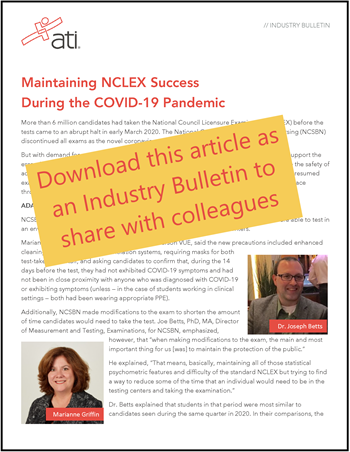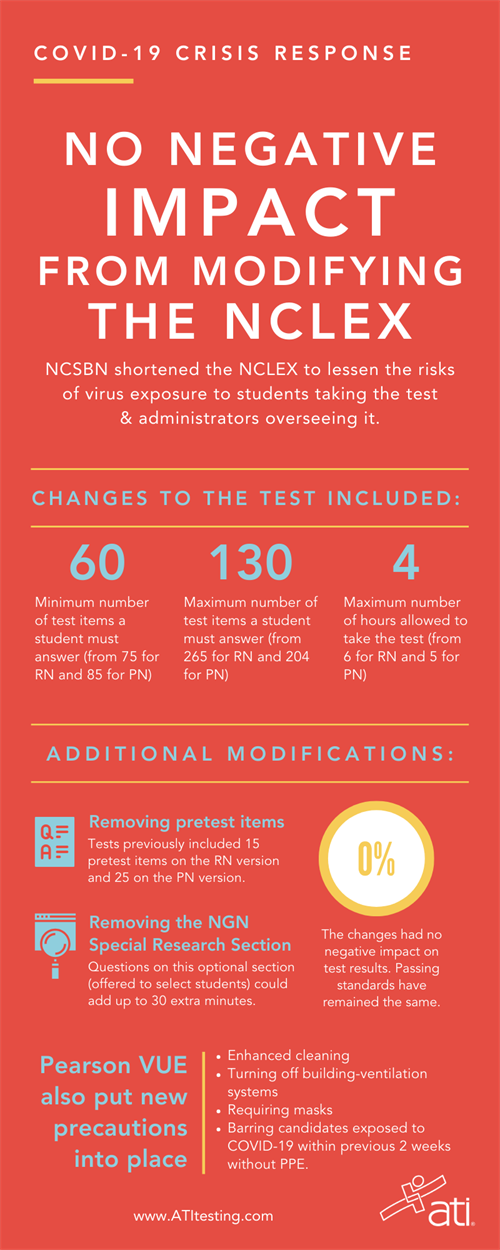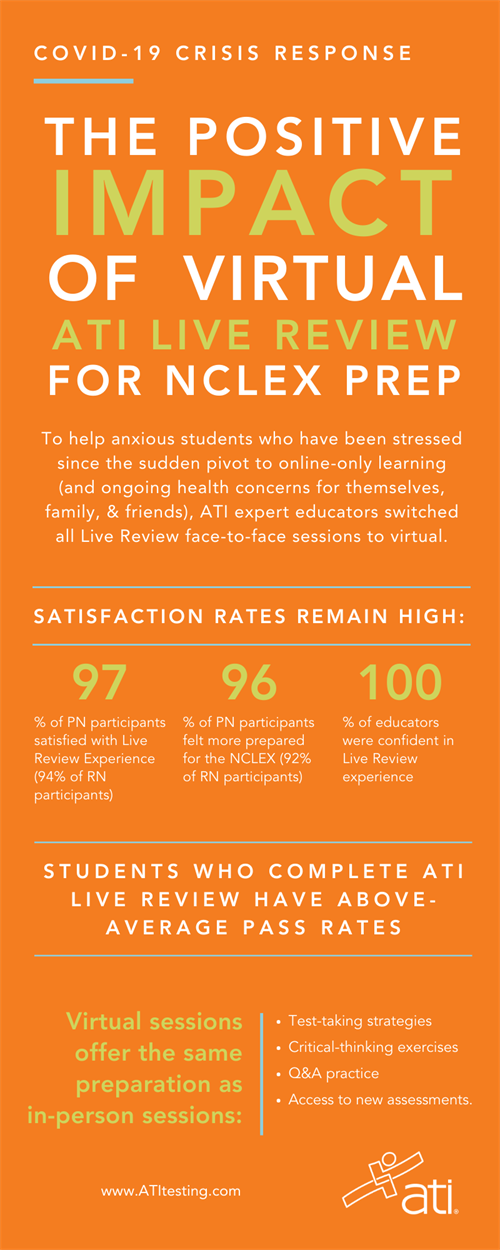Was it risky to change the NCLEX during the pandemic? Not at all.
How NCSBN took on the COVID-19 crisis to maintain NCLEX success
 More than 6 million candidates had taken the National Council Licensure Examination (NCLEX) before the tests came to an abrupt halt in early March 2020. The National Council of State Boards of Nursing (NCSBN) discontinued all exams as the novel coronavirus pandemic swept across the globe.
More than 6 million candidates had taken the National Council Licensure Examination (NCLEX) before the tests came to an abrupt halt in early March 2020. The National Council of State Boards of Nursing (NCSBN) discontinued all exams as the novel coronavirus pandemic swept across the globe. But with demand for nurses greater than ever, NCSBN immediately began exploring steps to support the essential flow of new nurses into the healthcare system. Thus, after making changes to enhance the safety of administrative staff and those taking the test, U.S.- and Canada-based Pearson VUE test centers resumed examinations on March 25. Since then, nearly all test centers have opened with precautions in place through at least Sept. 30.
DOWNLOAD THIS ARTICLE AS AN INDUSTRY BULLETIN PDF TO SHARE WITH COLLEAGUES
ADAPTING TO CURRENT CONDITIONS
NCSBN worked closely with Pearson VUE to ensure that candidates for nursing licensure were able to test in an environment that followed CDC guidelines before reopening testing centers.
In a video shared by NCSBN, Marianne Griffin, Senior Program Manager for Pearson VUE, said the new precautions included enhanced cleaning, turning off building-ventilation systems, requiring masks for both test-takers and staff, and asking candidates to confirm that, during the 14 days before the test, they had not exhibited COVID-19 symptoms and had not been in close proximity with anyone who was diagnosed with COVID-19 or exhibiting symptoms (unless — in the case of students working in clinical settings — both had been wearing appropriate PPE).

DOWNLOAD THE INFOGRAPHIC AT RIGHT AS A HANDY REFERENCE
Additionally, NCSBN made modifications to the exam to shorten the amount of time candidates would need to take the test. In the NCSBN video, Joe Betts, PhD, MA, Director of Measurement and Testing, Examinations, for NCSBN, emphasized, however, that “when making modifications to the exam, the main and most important thing for us [was] to maintain the protection of the public.”
He explained, “That means, basically, maintaining all of those statistical psychometric features and difficulty of the standard NCLEX but trying to find a way to reduce some of the time that an individual would need to be in the testing centers and taking the examination.”
Dr. Betts explained that students in that period were most similar to candidates seen during the same quarter in 2020. In their comparisons, the NCSBN psychometricians rescored each candidates’ examination and looked at key indicators, such as passing rates, decision consistency, and high reliability. He said they deduced that the most efficient changes that still maintained the exam’s quality and integrity were to reduce the amount of questions and the time allowed to take the test.
Specifically, the changes were:
- Reducing the minimum number of test items to 60 (from 75 for RN and 85 for PN)
- Reducing the maximum number of test items to 130 (from 265 for RN and 205 for PN)
- Reducing the maximum testing time to 4 hours (from 6 hours for RN and 5 hours for PN)
- Removing pretest items (15 items for RN and 25 items for PN)
- Removing the Next Generation NCLEX Special Research Section (about 30 minutes).
POSITIVE RESULTS ASSOCIATED WITH MODIFICATIONS
Phil Dickison, PhD, RN, NCSBN’s Chief Officer of Examinations, recently discussed educators’ concerns about these changes with Sheryl Sommer, PhD, RN, CNE, Vice President and Chief Nursing Officer for ATI. He noted that educators had expressed concerns that pass rates would be negatively impacted by the modifications. The reality has been just the opposite, he explained. Not only have passing standards remained the same but the number of candidates who ran out of time had decreased.
He noted that educators had expressed concerns that pass rates would be negatively impacted by the modifications. The reality has been just the opposite, he explained. Not only have passing standards remained the same but the number of candidates who ran out of time had decreased.In the NCSBN video, Dr. Betts reiterated Dr. Dickison’s statements. “The NCLEX is measuring exactly the same today as it was a month ago as it was a year ago,” he stated. “The NCLEX continues to measure nursing ability exactly as it did before,” he explained, primarily due to the continued use of computerized adaptive testing (CAT) technology. “That allows for the algorithm inside the examination to select items based on the ability level of that individual. So each and every person is still getting the same type of examination as they would have gotten before.”
The overall conclusion? “These modifications don’t affect the statistical properties of exam,” Dr. Betts said. “It’s just as rigorous as it was before, and the examinations are no more or less difficult than they were before, because of the selection algorithm using the computerized adaptive testing.”
ACCOMMODATING INCREASED DEMAND
Most students prefer taking the NCLEX in July and August after they’ve graduated in the spring and had several months to review and prepare for the licensure exam. In previous years, testing-center hours were typically extended during those months. Now, however, because many candidates’ originally scheduled testing times were cancelled when centers closed, and test centers have only been able to reopen based on individual states’ relaxation of lockdown mandates, demand has been higher than normal since April. As a result, test centers have already begun offering extended hours — some offering availability nearly 24 hours a day, according to Pearson VUE.Despite these measures, July and August appointments are already fully booked.
USING VIRTUAL TECHNOLOGY TO PREPARE STUDENTS
 Students have experienced untold anxiety since the switch to online-only learning and concerns about COVID-19’s impact on themselves, friends, and family. Their anxieties about taking the NCLEX — a test often considered the most important of their careers — increased exponentially as a result.
Students have experienced untold anxiety since the switch to online-only learning and concerns about COVID-19’s impact on themselves, friends, and family. Their anxieties about taking the NCLEX — a test often considered the most important of their careers — increased exponentially as a result.To respond to the apprehensions of these vulnerable future nurses, who are in greater demand than ever, ATI nurse educators immediately evaluated how best to support them. In assessing ATI’s Live Review NCLEX preparedness offering — typically offered in person and face to face with students — ATI’s educators quickly pivoted to a fully virtual delivery model.
Studies have shown that students who completed an ATI Live Review had substantially higher NCLEX pass rates than the national average. In the current circumstances, then, it was crucial to ensure ATI’s Live Review could accommodate as many graduates as possible in becoming safe, competent nurses who were ready for practice.
ATI’s educators — all with master’s and doctoral degrees and classroom teaching experience — were soon delivering their engaging, interactive review courses using the teleconferencing-platform Zoom. Their virtual sessions offer the same crucial elements of test-taking strategies, critical-thinking exercises, Q&A practice, and access to new assessments as their in-person sessions did pre-COVID-19.
DOWNLOAD THE INFOGRAPHIC AT RIGHT AS A HANDY REFERENCE
POSITIVE, HIGHLY SATISFIED PARTICIPANTS
Outcomes — along with student satisfaction — have proven the success of this pilot effort. Of nearly 27,000 RN students and almost 3,500 PN students who participated in these recent Online Live Reviews, students rated the experience with extremely high marks. 99% of PN and 98% of RN participants were satisfied with the educators who delivered the sessions, with 97% of PN individuals and 94% of RN stating they were satisfied with the Live Review experience. As importantly, 96% of PN and 92% of RN graduates said they felt more prepared to test for the NCLEX.
Nursing faculty delivered even higher ratings. 100% (74 educators) stated they had confidence with the ATI Live Review preparation for NCLEX.
Reasons for their high satisfaction ranged from ease of scheduling, flexible days, and ability to combine groups to not needing to secure classroom space, and the safe online environment that increased student participation by encouraging them to ask questions.
Specific comments have included:
- No dull moments. One instructor at a PN program in the Midwest stated that her students’ Live Review experience was “engaging” and “informative” during a stressful period. She wrote that the Live Review session offered “just the right balance of information, opportunity for interaction, and a special touch of humor. This is a very trying time for our students, and your approach was great. I am glad I had the opportunity to listen in, even if it was because of COVID-19.”
- Heart-felt gratitude. An educator at a Texas program wrote that her campus sincerely appreciated ATI educators’ work to deliver the Live Review in a virtual format. “The COVID pandemic has certainly changed our normal delivery of learning this quarter,” she added.
- Delivery beyond expectations. When one instructor at a midwestern community college realized she had given students the wrong date for their Live Review session, she wrote to formally acknowledge her ATI educator for “going above and beyond” in helping to accommodate the issue. ATI’s instructor “stepped up and saved the day,” the Des Moines instructor wrote. “She offered to run the review starting that day and was ready to go in less than 2 hours. Knowing the students had likely made scheduling arrangements in order to attend, I cannot express how much I appreciated [her] rearranging her schedule to make this happen. … She truly went above and beyond to put our students first.”
- Supportive “naysayers.” An East Coast program stated her students typically complain about having to attend their RN Live Review so close to graduation. This year, a few even asked to be excused. However, she said that she joined the virtual program several times and noticed that the students who had been most vocal in not wanting to participate were actively responding to the ATI educator’s questions and remained present the entire 3 days. “It was a great class and worked well on the virtual platform,” she said.
While ATI nurse educators enjoy the ability to deliver their reviews in person with students, educators’ and students’ responses allowed them to recognize that they could connect and prepare graduates just as effectively via virtual technology.
Ensuring that students can prepare for this crucial test as effectively during a pandemic as they could prepandemic is the ultimate test of NCLEX readiness.
